|
Saturday,
September 15’Th
Mary has
prepared the breakfast for 7 am, because I have to reach the ferry for Rossaveal
at 8.30. From Rossaveal there’s a bus for Galway, where I hurry to the
bus-terminal to reach the 10.30 to Dublin.
Then there’s an
annoying 4 hour bus-ride before I jump off just in the city-center at a bus stop
by the River Liffey.
From there it’s
a short walk to one of the greatest sights in Dublin – the
Trinity Collage. This sight has got that
special quality, which I will be staying there for the rest of this vacation.
Like in Belfast the university rents out for tourist during summer, and I have
been lucky to get a room. So I pick up the key-card to room 47.1.04 which get’s
me into a very nice and useful room. |
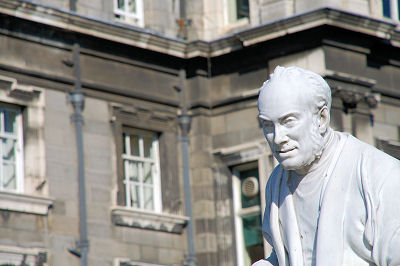 |
|
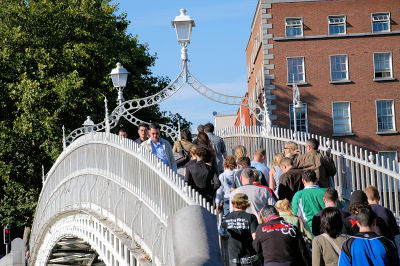 |
Trinity Collage is the most prestigious in Ireland. It was
established by Elizabeth I in 1592. At that time, it was in the
outskirts of the city. But the city has grown much bigger, and now
it’s smack downtown. Until 1793 only Protestants were allow to study
here. These days most of the 13.000 students are Catholics, even
though the Catholic Church actually didn’t allow it’s supporters to
go for this university until 1970.
The
major Irish Tourist-trap is also here. “The Book of Kells” is an
illustrated version of the New Testament. It was made about year 800
a.c. It is on show here, and I saw it last time I was in Dublin. Or
rather – I saw one page – from a distance – for about 5-10 seconds –
after queuing for hours. I won’t do that mistake this time – The
Book of Kells will not have my visit this time. |
|
Instead I go to see a bit more of Dublin. This is very different
just arriving from Inishmore. Temple Bar is just beside Trinity
Collage, so I find myself a decent pub, get myself some pub-grub and
a pint, and watch 2’nd half of a football-match. Temple Bar is not
that big, so it’s slowly moving onto the other side of River Liffey
via the new pedestrian-bridge called Millennium Bridge. The rest of
the day is spent walking around Dublin center. You have to walk a
little faster here than on Inishmore, or else you will be overtaken
all the time. |
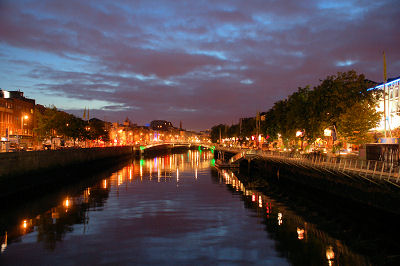 |
Sunday,
September 16’Th
|
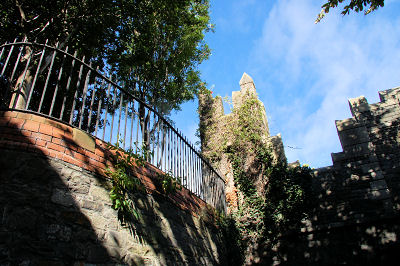 |
It’s breakfast at Trinity Collage Dininghall. It’s a nice place from
1743 with large tables and paintings of the old masters on the wall.
Then it’s off to see a bit more of Dublin. I have brought my own
guide. From the Dublin Tourism’s homepage
I have downloaded a number of Podcasts with different tours in
Dublin. Now I have them available on my IPod, ready for use.
First tour is called “Viking & Medieval Dublin”. It brings me past
some of the oldest parts of Dublin. You get to see the City Walls –
or what’s left of them. You also pass the oldest pub in Dublin and
the very nice St. Audeons Church, which is the only medieval-church
in Dublin still in use. It was built between 1181 and 1212. In the
front of the church there’s a nice little park, with some people
smoking funny tobacco – much to the dislike of the policemen that
patrols the park. |
|
Finally the tour reaches Christ Church Cathedral. It was built
during several periods, and the style seems a little messy. It’s not
always been easy to be a Protestant Church in Catholic Ireland, so
it has had its ups and downs. The queue for entering is way to long
for my taste, so I head for a local pub for an omelet and a pint
instead. And just as I get inside, it starts to rain – so another
wise decision.
The
Podcast guide is very fine, but you have to remember to bring a map
or you will get lost. I didn’t on this tour and that was a mistake. |
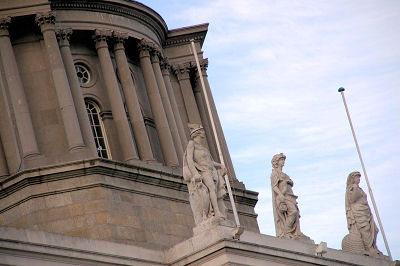 |
|
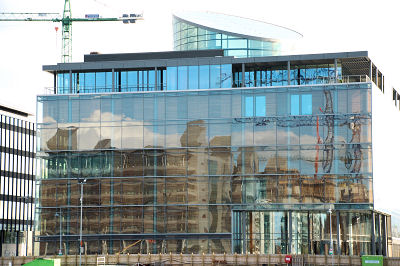 |
Pod-Tour 2 is called “Temple Bar to The Docklands”. It starts – of
course – with a short tour around Temple Bar, where you are told
about the history and the buildings in the area. Then you cross the
River Liffey and continue east passing many fine bridges, including
the Ha’penny Bridge and the big one – O’Connell Bridge. Then you
reach the Custom House, which is a very impressive building build in
1790. There has been much trouble around this place, and it was
almost burned downed in one of the independence-battles in 1921.
Later it was rebuilt again.
The
tour continues along the river to the
Dublin Docklands. Like
the big brother in London this a development area, made out of parts
of the harbor that for years have been out of business. Now there
are hotels, offices, apartments for the filthy rich and a huge
conference-center. All is made out of glass and steel like it has to
be these days. |
Here the
Pod-tour is ending, and I have to find my own way back to Trinity Collage. I do
that by crossing River Liffey again, on a bridge so new that it’s not even on my
map. Then I head back via some residential areas still waiting for the
development to arrive.
|
Monday, September 17’Th
First trip of the day is to the outskirts of Dublin – to Kilmainham.
I start the trip on Luas, the new
light rail in Dublin, to Heuston Station. From there it is on foot
to 3 different sights.
The
first sight is Royal Hospital
Kilmainham. It was build between 1680 and 1687, and had the same
purpose as Hotel Invalide in Paris, namely to cater for wounded
soldiers from the wars. It functioned as that until 1928. In 1980’s
they started to restore the fine buildings. Now it houses the Irish
Museum of Modern Art. Thankfully it’s closed today, so I don’t have
to find an excuse to stay out. But the building and the park
surrounding the building is very nice. |
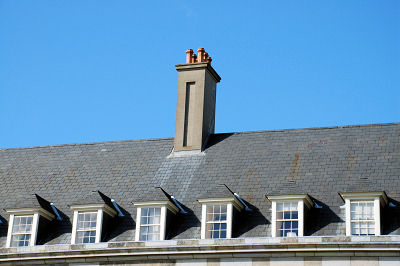 |
|
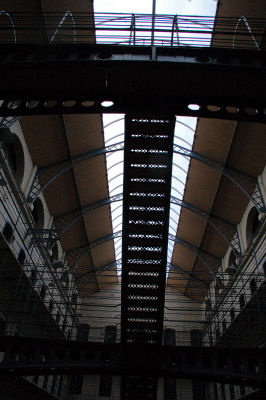 |
Then I walk through the park to Kilmainhaim Gaol. It’s a prison,
made back in 1795, who has played an enormous role in Irish history.
After the risings in 1798, 1803, 1848, 1867 and 1916 against the
British all the leaders of the uprising always went here. In
connection with the Easter-rising in 1916 14 leaders were executed
here. This episode was very much changes the atmosphere in Ireland,
which until then not necessarily was pro-rising so to say. But after
the executions the rising got backed by the people of Ireland.
There’s a very fine guided tour around the prison where you hear
some of the stories. Among them is the story of the leader who
married his fiancÚ in prison – just to be taken to the yard 2 hours
later and shot. And another one who was wounded, and wasn’t even
able to stand up during his own execution. Friendly as the British
were, they allowed him to sit down.
From the prison there’s a small walk towards the War Memorial
Gardens. This is a very fine park that runs all the way down to
River Liffey. It was built to remember the 49.400 Irish soldiers
killed during WW1 and has plenty of huge monuments. |
|
From there I walk back to Heuston Station and take a Luas back to
city-center. By the way – Luan means “Fast” on the Gaelic language.
Tour no. 2 is more in the center. I start at Trinity Collage and
walks along Dame Street. First I reach the City Hall which was built
in 1779. There’s a very fine hall that I get to see just before
closing-time.
Right behind is Dublin Castle.
It was built during a longer period, and you can see that. There’s a
very fine tower in the corner, which looks just as it was built in
1258. They have tours of the castle, but it’s too late for today.
That’s fine for me. Behind the castle there’s another fine park. A
guy is sitting on a bench playing a Didgeridoo – hmmm – maybe he’s
in a wrong place on this planet. |
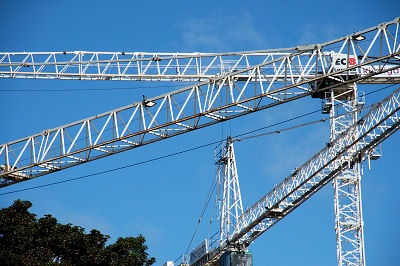 |
|
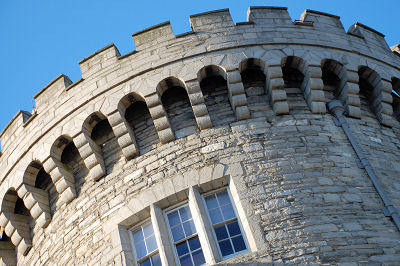 |
Further on to St. Patrick’s Cathedral. Together with Christ Church
Cathedral these are the 2 largest churches en Ireland – and they are
both Protestant churches, which is weird in a Catholic country. If
front of the church there’s another another fine park. There are
weird persons here as well. A group is standing in the middle
singing. Jesus – is there no normal people around these places?? -
I start to think – until I realize that the group is a choir from
Denmark – shame on them – do behave when abroad please.
The
church was built between 1190 and 1225. No one really knows when. As
many such building it has its stories to tell about fire and
troubles. I guy named Oliver Cromwell, who visited Ireland in 1649
actually used the church as a stable for his horses. I take a look
inside, but there’s a service going on so I’m quickly out again.
From there it is back to Trinity Collage. I have done enough
sightseeing for today. |
|
Tuesday, September 18’Th
It’s the last day on this trip and it’s cold and windy. This is an
exception; the weather during the trip has been very nice.
Tour no. 1 is passing some of the fine parks in Dublin. First it’s
St. Stephens Green a short walk from Trinity. This is supposed to be
the most popular park in Dublin, where you can feed the ducks and
take a walk and look at the flowers and trees. There is a very fine
photo-exhibition in the park, with a lot of big photos of endangered
species.
From there it’s another short walk to a fine park at Merrion Square.
It is probably even nicer. But there are no ducks here. Instead
there are some fine statues of different local celebrities. Oscar
Wilde was one of them.
Merrion Square is a nice neighborhood. Around it, it is full of
Georgian houses with fine fainted doors and spectacular door-knobs.
In front of them there are special devices so you can get rid of the
mud on your boots before entering the fine houses. These days most
of the houses are inhabited by lawyers, designers and
marketing-businesses, who seem to make so much money that they can
afford the rent. |
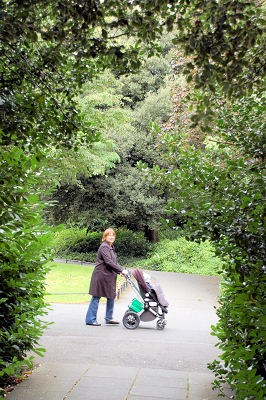 |
|
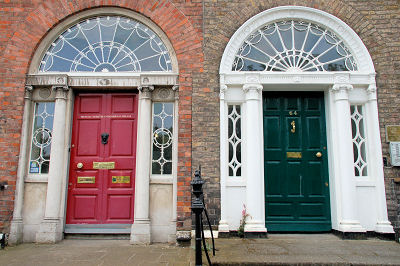 |
Lunch is at a fancy pub called “The Bank”. Mashed potatoes and spicy
sausages are recommended.
Tour no. 2 is through Temple Bar to the areas central spot Meeting
House Square. There is an exhibition in the National Photographic
Archive that I would like to see. It’s a local
newspaper-photographer, who is on show. The pictures are ok – but in
my opinion nothing more than that. Why exactly these photos had to
be on exhibition – I really don’t understand. By the way – Temple
Bar – like the Book of Kells and Guinness – is a major tourist-trap
if you ask me. Really nothing much around here except for a few
bars, that you can find much better in other places of Dublin. There
are clearly more interesting places in Dublin than these 3 high
profiled ones.
Finally I head up and down O’Connell Street. This is the old
shopping-street of Dublin, who is now being restored. There are some
statues in the middle of the road. Among them the 120 m. high steel
thing called Spire. It’s supposed to be the tallest sculpture on
earth. It has been placed there instead of an old statue of Admiral
Nelson, which someone blew up in 1966. |
Dinner is the
first pizza on this trip, before I finish my Dublin-visit with a pint at a pub
that is showing Porto vs. Liverpool on the big screen.
Wednesday,
September 19’Th
I’m leaving
Dublin Airport at 11.30. I’m arriving Billund Airport at 2.30, and is back home
at 3.30 – and it’s still raining.
Back to
frontpage |











